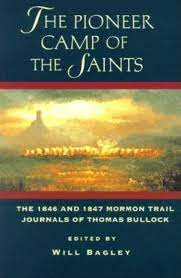Articles/Essays – Volume 33, No. 1
A Welcome Arrival, A Promising Standard | Will Bagley, ed., The Pioneer Camp of the Saints: The 1846 and 1847 Moron Trail Journals of Thomas Bullock
The 150th anniversary celebrations of the exodus from Nauvoo, Illinois, to the Rocky Mountains saw the publication of several significant new works in Mormon history. Surely one of the most significant contributions of these is Will Bagley’s edition of the Thomas Bullock journals of 1846 and 1847. Bagley and his publishing team are to be commended for bringing this vital and illuminating original document into public view. Whatever criticisms follow pale in importance to the fact that Bagley has produced this valuable book. The English-born Bullock himself mars his record with small minded complaints and petty criticism of the men around him, and his officially appointed record does not quite compare to the writings of contemporary diarists William Clayton, Orson Pratt, or Wilford Woodruff. Still, Bul lock’s account is a unique and wonderful addition to the literature of the Mormon trek.
The administration of the Church Historical Department of The Church of Jesus Christ of Latter-day Saints is also to be commended for the support and encouragement given this project. The publication of this original document may evidence a changing attitude, a refreshing recommitment to bringing to light important sources long neglected or forgotten in church archives. One can only hope that we will not have to wait for other anniversary celebrations to see more such publications.
The Pioneer Camp of the Saints has much to recommend it. Handsome and easily readable, the book features many photographs, detailed tables, and lists of rosters and mileage charts. Bagley’s helpful introduction and life sketch of Bullock cover almost 25 pages, and each chapter or sub-section of the diaries is preceded by its own historical overview and explanation. An excellent index and a detailed appendix identifying many names appearing in the journal complete the volume.
Bagley’s editing of the Bullock journal is professional. Scores of names, places, and events encountered along the way are described and detailed helpfully in footnotes, but footnotes are reasonable in number and size and do not overwhelm the text. Not since Juanita Brooks’s study on Hosea Stout (On the Mormon Frontier: The Diaries of Hosea Stout [University of Utah Press, 1964]) has there appeared a better edited Mormon journal.
More importantly, Bagley has been faithful to the original record, complete with intended—but stroked out— words and phrases and original gram mar and spelling. There are no nagging ellipses, emendations, or revisions. In short, it is printed here and now as it was written there and then. And Bagley has gone one step further by incorporating helpful excerpts from Bullock’s later letters and writings, especially those that appeared in the Millennial Star of 1848 in which he discussed the recent journey. He also integrates into the text key minutes of council meetings held along the trail, documents that Bullock wrote in his own hand as recorder to the Council of the Twelve. To the extent these records are included—and one is chagrined that more have not survived—Bullock’s diary is as much the official record of the exodus as it is a personal account.
The work is not, however, without errors or weaknesses. These appear particularly in certain of the editor’s historical and doctrinal explanations. If, for instance, the treatment of Samuel Bran nan’s life and intentions is sound and thorough, the same cannot be said with regard to James Emmett and George Miller. These men were not acting under Brigham Young’s wishes when they set led in the Pawnee Village on the Niobrara in 1846/47. Instead, they were following their own course of borderline rebellion, one that soon took them out of the church. Bagley’s inclusion of Bul lock’s Poor Camp journals of 1846 is commendable, but fails to incorporate recent scholarship (See esp. The Iowa Mormon Trail: Legacy of Faith and Courage [Orem, Utah: Helix Publishers, 1997]). Bagley’s thoroughness in describing people and places is sadly lacking when it comes to clarifying the theology of the exodus. Missing are explanations for Brigham Young’s May 26 sermon in Scottsbluff, the purpose of prayer circles, the Law of Adoption, the meaning of rebaptisms upon reaching Salt Lake Valley, and of other doctrines and practices peculiar to the trek. Bullock understood these things implicitly, but the editor needs to help the reader. Bagley minimizes or perhaps misunderstands the differences between Young and Pratt in their trail confrontation of August 1847. It wasn’t “a possible rival for leadership of the church,” but differing views on the role of the Twelve that was at issue (268). For such a complete journal with so many footnotes on rivers, ridges, and terrain, why only a single map on the last 100 miles of the trek? And way are some of the finest contemporary journals—by Horace K. Whitney, Erastus Snow, A. P. Rockwood, and Appleton Harmon—so little referenced or noted. Bullock was not alone, and a discussion, however short, of the other journalists of the exodus would have strengthened this work.
These are, however, quibbles and should not distract or dissuade the scholar, student, or history buff from reading and relishing this work. One can only hope that the remaining offerings in this series of original documents will measure up to the standard set here by Bagley.
The Pioneer Camp of the Saints: The 1846 and 1847 Mormon Trail Journals of Thomas Bullock. Edited by Will Bagley (Spokane, Washington: Arthur H. Clark, 1997), 393 pp. Volume 1 in the series: “Kingdom in the West: The Mormons and the American Frontier.”


 Back to full Issue
Back to full Issue

